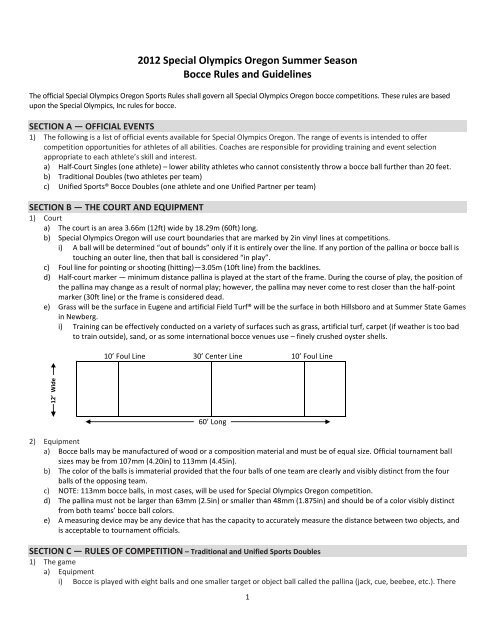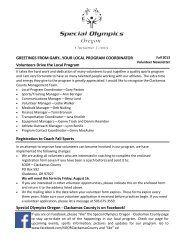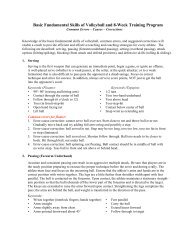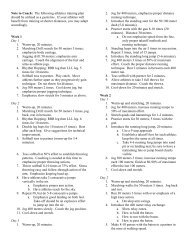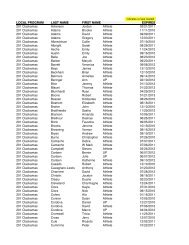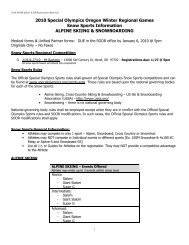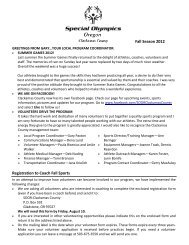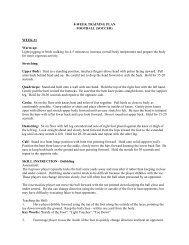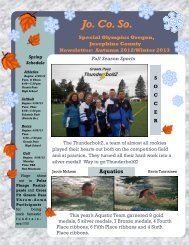2012 Special Olympics Oregon Summer Season Bocce Rules and ...
2012 Special Olympics Oregon Summer Season Bocce Rules and ...
2012 Special Olympics Oregon Summer Season Bocce Rules and ...
You also want an ePaper? Increase the reach of your titles
YUMPU automatically turns print PDFs into web optimized ePapers that Google loves.
are four balls to a side or team, <strong>and</strong> they are generally made in two colors to distinguish the balls of one team fromthose of the opposing team.b) Pallina <strong>and</strong> colori) A coin toss by the referee will determine which team has the pallina <strong>and</strong> choice of ball color. In the absence of areferee, the two team captains will execute the coin toss. The coin toss should take place on the court.c) Three-attempt rulei) The team possessing the pallina will have three attempts at placing the pallina beyond the 9.125m (30ft) mark <strong>and</strong>before the 3.05m (10ft) mark on the opposite end. If these three attempts are unsuccessful, the opposing team willhave one opportunity to place the pallina. If this attempt is unsuccessful, the referee will place the pallina in the centerof the court at the 15.24m (50ft) mark (opposite end foul line). However, at no time does a team lose its earned pallinaadvantage of being able to deliver the first ball.d) Sequence of playi) The pallina is rolled or tossed by a member of the team having won the coin toss to start the game. The player tossingthe pallina must deliver the first ball. The opposing team will then deliver their bocce balls until the point is taken orthey have exhausted their four balls. This “nearest ball” rule governs the sequence of played balls. The side whose ballis the closest to the pallina is called the “in” ball <strong>and</strong> the opposing side the “out” ball. Whenever a team gets “in,” itsteps aside <strong>and</strong> allows the “out” team to deliver.e) Initial pointi) It is always incumbent upon the team with the pallina advantage to establish the initial point. Example: Team A tossesthe pallina <strong>and</strong> delivers the first ball. Team B elects to hit Team A’s ball out of position. In doing so, both balls, Team A’s<strong>and</strong> Team B’s, fly out of the court, leaving only the pallina in the court. It is incumbent upon Team A to re-establish theinitial point.f) Ball deliveryi) A team has the option of rolling, tossing, bouncing, banking, etc., its ball down the court, provided it does not go out ofbounds or the player does not violate the foul markers. A player also has the option of hitting out any ball in play intrying to obtain a point or decrease the opposing team’s points. A player can grip the ball by placing his/her h<strong>and</strong> overor under the ball as long as the ball is released in an underh<strong>and</strong> delivery. An underh<strong>and</strong> delivery is defined as releasingthe ball below the waist.(1) The Competition Director shall have the discretion to allow for certain modifications/interpretations of the currenttechnical rules based upon a physical disability characteristic. Such interpretation shall be requested <strong>and</strong> ruled onprior to the athlete’s participation in a competition <strong>and</strong> shall not give advantage over another athlete. Deliveryaction interpretations will be concerned with the action a limb(s) is performing a throw or roll.g) Number of balls played by a playeri) Two-Player Team — each player is allowed to play two balls.h) Coachingi) Discussion with any athlete <strong>and</strong>/or partner is prohibited once the athlete <strong>and</strong> or partner steps onto the court.ii)If an official determines that a coach/ partner/ spectator is violating this rule, the official may sanction the offendingindividual. Sanctions may include: verbal warning, citing the coach/partner with unsportsmanlike conduct or expulsionfrom the game.i) Scoringi) At the end of each frame (when both teams have exhausted all balls), scoring will be determined as follows: points areawarded to the team whose balls are closer to the pallina than the closest ball of the opposing team, which can bedetermined by viewing or by mechanical measurements. A player may request a mechanical measurement(Measurements will be taken from the center side of the bocce ball to the center side of the pallina). At the end of aframe, the referee announces the winning points <strong>and</strong> color to the players outside the court at the pallina end <strong>and</strong>before the balls are removed, the referee should look to the players for agreement. The players have a right to requesta measurement if the players disagree with the referee. When the player or team agrees with the number of pointsawarded, the court official then proceeds to remove the balls to start the next frame. The scoring team for each framewill also win the pallina advantage for the subsequent frame. The referee will be responsible for validity of thescoreboard <strong>and</strong> scorecard, so it is incumbent upon the team captain to verify the accuracy of the posted score at alltimes.j) Ties during framei) In the event that two opposing balls are equidistant from the pallina (tied), the team that rolled last will continue to rolluntil the tie is broken. Example: Team A rolls a ball toward the pallina <strong>and</strong> establishes the point. Then Team B rolls itsball toward the pallina, <strong>and</strong> the referee determines that they are both exactly the same distance from the pallina. TeamB must continue to roll until it has a point closer than Team A’s ball. If Team B does roll up to the point, <strong>and</strong> Team A hitsthat ball out re-establishing a tie, Team A must continue to roll until the tie is broken.2
ii) Player plays more than his allotted number of balls(1) When a player rolls an extra ball during a frame, the ball in question is declared dead. The referee will wait untilthe just released ball comes to a complete stop <strong>and</strong> then remove the just released ball from the court. If the ballcomes in contact with the other balls on the court or the pallina <strong>and</strong> these balls are moved from their originalposition, the referee will place the balls back as close to their original position as possible <strong>and</strong> play will continue.This condition will exist when a player on a two-player team plays three balls instead of two. Two-Player Team —the remaining player on a two-player team will only have one ball to play.iii) Illegal movement of a ball belonging to your own team(1) If a player moves one or more of his or her team’s balls, the ball(s) are removed from the court <strong>and</strong> considereddead <strong>and</strong> play continues.iv) Illegal movement of an opponent’s ball(1) If, after all eight balls have been thrown, a player moves one or more of his/her opponent’s balls, the opponent’sballs that were moved will be awarded one point each. If a player moves one or more of his/her opponent’s balls,<strong>and</strong> there are remaining unplayed balls, the referee will place the balls as close to their original position as possible<strong>and</strong> play will continue.v) Illegal movement of the pallina by a player(1) If the pallina is moved by a player, the opposite team will be awarded as many points as the number of live ballsthat were “in contention” plus the number of balls yet unplayed. If the team fouled against has no balls “incontention” <strong>and</strong> no balls remaining, then the frame will be declared over by the referee <strong>and</strong> started over at thesame end.c) Accidental or premature movement of balls or pallina by an officiali) Accidental movement of a ball or pallina during play (when more balls are yet to be played)(1) If an official, either in the course of measuring or otherwise, moves a ball “in contention” or the pallina, the frameii)is considered dead <strong>and</strong> started over at the same end.Accidental or premature movement of a ball or pallina, by an official, after all balls are played.(1) If the point or points were obvious to the official, the points will be awarded. All uncertain points will not beawarded <strong>and</strong> the frame is considered dead <strong>and</strong> started over at the same end.d) Interference with a ball in motioni) By one’s own team(1) When a player interferes with his/her team’s ball in motion, the official, as a result of witnessing the foul, mustdeclare the ball being thrown dead. The dead ball is then removed from the court. The official, after declaring afoul, should attempt to stop the advancement of the ball as it proceeds down the court, so that it doesn’t strikeany balls in play. If the official cannot stop the ball as it advances down the court, the official will wait until the ballcomes to a complete stop <strong>and</strong> then remove that ball from the court. If the ball comes in contact with the otherballs on the court or the pallina <strong>and</strong> these balls are moved from their original position, then the official will placethe balls back as close to their original position as possible <strong>and</strong> play will continue.ii)By opponent’s team(1) If a player interferes with an opponent’s ball in motion, the team fouled against has one of the following options:(a) Play the ball over.(b) Declare the frame dead.(c) Decline the penalty, accept the lie of the touched ball(s) <strong>and</strong> continues playing.iii) With no disruption of position(1) If a spectator, animal or object interferes with a ball in motion <strong>and</strong> that ball does not touch another ball already inplay, it must be played over by the same player.iv) With disruption of position(1) If a spectator, animal or object interferes with a ball in motion <strong>and</strong> that ball touches another ball already in play<strong>and</strong> “in contention” the frame is dead.v) Other disruption of play(1) Any action which interferes with the position of the pallina or the ball of each team closest to the pallina rendersthe frame dead. In the event balls other than the pallina or the two opposing balls closest to it are moved, theymay be replaced as close as possible to the original position by the two captains or the official. Such disruptiveaction may be the result of a dead ball from another court, foreign objects, spectators or animals entering thecourt <strong>and</strong> changing the position of the ball(s) in play.vi) Wrong color delivery(1) Replaceable(a) If a player delivers a wrong color ball, the ball may not be stopped by another player or the official. The ballmust be allowed to come to rest <strong>and</strong> replaced with the proper colored ball by the official.4
(2) Not replaceable(a) If a player delivers a wrong color ball which cannot be replaced without disturbing another ball already in play,the points of the play will be recorded at that time, wrong color ball counting for the team which rolled ordelivered it, <strong>and</strong> play will continue. It will be the responsibility of the two team captains <strong>and</strong> the official tomaintain identity of the “wrong color” ball(s).vii) Wrong rotation of play(1) Initial point(a) If a team wrongly delivers the pallina <strong>and</strong> its first ball, the official will return both pallina <strong>and</strong> the ball <strong>and</strong>begin the frame over from the same end.(2) Subsequent rolls of the proper color in improper sequence(a) If a player delivers his or her ball when his or her team is “in” <strong>and</strong> the other team still has balls left, the ball inquestion remains where it comes to rest, is considered “live” <strong>and</strong> play continues. This ruling holds true,regardless of who indicated which ball was “in,” since it is the responsibility of each team to request ameasurement when an “in” point is questionable.6) Officialsa) Objectionsi) Objections to official(1) Each team has the right to object to a designated official for any reason prior to the start of a game. This objectionwill be considered <strong>and</strong> decided upon by the Competition Director.ii)Participant officials(1) No member of a team or registered substitute of a team will be allowed to assist in the officiating of a game inwhich that team is also playing.b) Substitute officialsi) During a game(1) Substitutions of officials may occur during a game only with the permission of the Competition Director <strong>and</strong> bothteam captains.ii)Additional officials(1) Additional officials may be assigned to any games during the course of play, provided permission is granted by theCompetition Director.iii) Team requests(1) Officials may be changed during the course of a game if either team presents sufficient cause to the CompetitionDirector.iv) Official’s uniform(1) Referees should be clearly distinguishable from players.c) Ethicsi) Official’s Code of Ethics(1) An official will:(a) Study the rules of the game.(b) Be fair <strong>and</strong> unbiased in his decisions, rendering them without regard to the score.(c) Be firm, but not overbearing; courteous, but not ingratiating; positive, but never rude; dignified, but notarrogant; friendly, but companionable; calm, but always alert.(d) Be prepared, both physically <strong>and</strong> mentally, to administer the game.(e) Not give information which would benefit or give advantage to one team over another.7) Other circumstancesa) Broken balli) If during the course of a frame a ball or pallina should break, the frame will be considered dead. Replacement of a ballor pallina will be the responsibility of the Competition Director.b) Court groomingi) Prior to play(1) All courts must be groomed to the satisfaction of the Competition Director before the start of each game.ii)Court grooming during play(1) Courts may not be reconditioned during the course of the game. Obstacles or objects such as stones, cups, etc.,may be removed during the course of a game.iii) Unusual court conditions(1) If in the opinion of the Competition Director, the court conditions are such that play is impractical, the game canbe stopped <strong>and</strong> resumed on another court or at another designated time.5
c) Moving ball or pallinai) No player may play his or her ball until a pallina or another ball has come to a complete rest.d) Mechanical aidi) If due to a medical or physical condition an athlete requires the use of a mechanical aid to spot the position of thepallina, then discretion can be given to the Competition Director for this to be permitted. Items such as a bell or brightcolored cone for a visually impaired athlete are examples of this type of mechanical aid. If a cone is used as amechanical aid it should be placed as close as possible to the pallina, usually behind, <strong>and</strong> removed from the court oncethe bocce ball is released from the athlete’s h<strong>and</strong>. If a bell is used it should be rung while held over the pallina.8) Player behaviora) Whenever possible, a player should move off the court when an opponent is playing.b) Unsportsmanlike conducti) Players shall act in a sportsmanlike manner at all times. Any act which is deemed as poor sportsmanship, such asinsulting language, gestures, actions or words which engender ill will, if flagrant, may result in disqualification.c) Attirei) Proper attire(1) Players will dress in a manner which will bring credit to them <strong>and</strong> the sport of bocce.(2) No jeans or denim pants or shorts of any color are permitted.ii)Footwear(1) Players will not be permitted to wear shoes which may damage or disrupt the court surface.(2) All players must wear close-toed shoes.iii) Objectionable attire(1) Players who wear objectionable or offensive clothing, or who are improperly attired, may not be allowed toparticipate in a tournament.SECTION D - MODIFIED COMPETITION – Half Court Singles Competition1) Half Court Singles Competition is intended for ramp bocce players <strong>and</strong> lower ability athletes who cannot toss the bocce orpallina ball 20 feet or more. This is a singles event only2) When participant numbers allow, ramp competitors will be divisioned separately.3) Athletes should be prepared to throw a bocce ball ranging anywhere in size from 107mm to 113mm in this event.4) Please note the following modifications to the st<strong>and</strong>ard <strong>Special</strong> <strong>Olympics</strong> <strong>Oregon</strong> bocce rules which apply to Half Court SinglesCompetition.a) The courti) This event will be played on a 12ft x 30ft court. Sidelines should be along the entire length of the court. The end linewill be the ‘foul’ line <strong>and</strong> be marked with chalk or marking paint or other indicator whenever possible. There will be nocenterline or “kitchen line” in half court, so the pallina ball can end up anywhere on the court.b) Athletes will always throw from only one direction in half-court bocce.c) Should the “three attempt rule” need to be employed in half court bocce, then the pallina will be placed 20ft from thethrowing line in the center of the court (equidistant from each sideline).d) Winning scores for Half Court Singles Competition = 8 points.e) Coaching in Half Court Singles Competition is permitted, but only outside of the throwing area. Once the athlete enters thethrowing area, then coaching is no longer allowed.f) All ramps <strong>and</strong> other assistance devices may be used with the approval of the <strong>Special</strong> <strong>Olympics</strong> <strong>Oregon</strong> <strong>Bocce</strong> CompetitionCommittee.i) If a ramp is used, athlete can position the ball with or without assistance <strong>and</strong> pushes the ball down the ramp towardthe target. An assistant (coach or volunteer) may guide, align, or direct ramp <strong>and</strong> athlete but may not assist with theball’s forward movement. In the divisioning process, the competition committee will consider half court bocce playersby overall ability <strong>and</strong> level of assistance needed to provide fair <strong>and</strong> meaningful competition for all competitors.g) The game will be played according to the <strong>Special</strong> <strong>Olympics</strong> <strong>Oregon</strong> <strong>Bocce</strong> rules except where noted above.SECTION E — DEFINITION OF PLAYING TERMS1) Ball: Live <strong>and</strong> deada) A live ball is any ball in play that has been delivered.b) A dead ball is any ball that has been disqualified or forfeited. A ball may be disqualified if:i) It is the result of a penalty.ii) It has gone out of the court (must be completely over the outside line).iii) It has come in contact with a person or object which is out of the court.iv) It is the result of a foot foul.6


